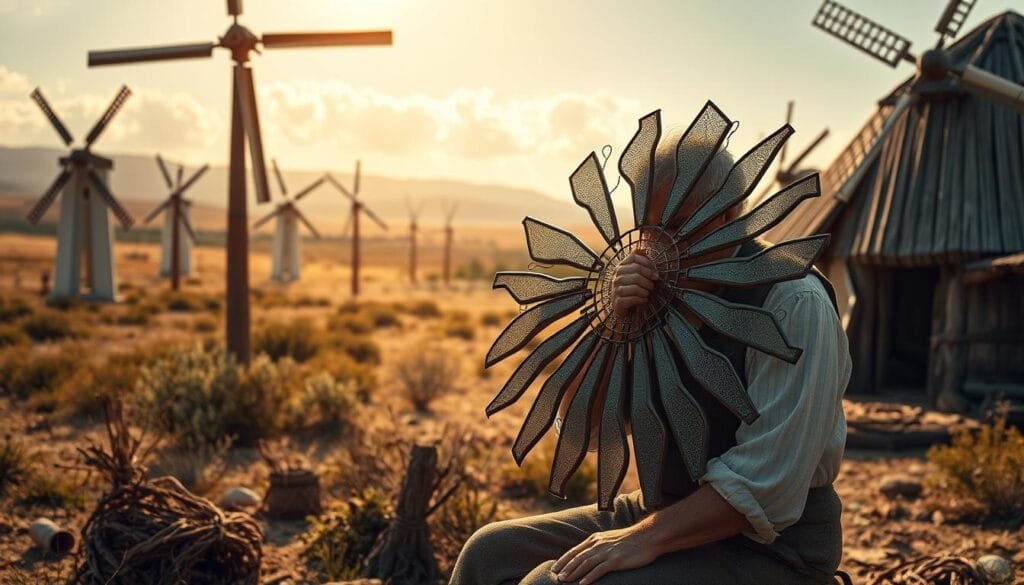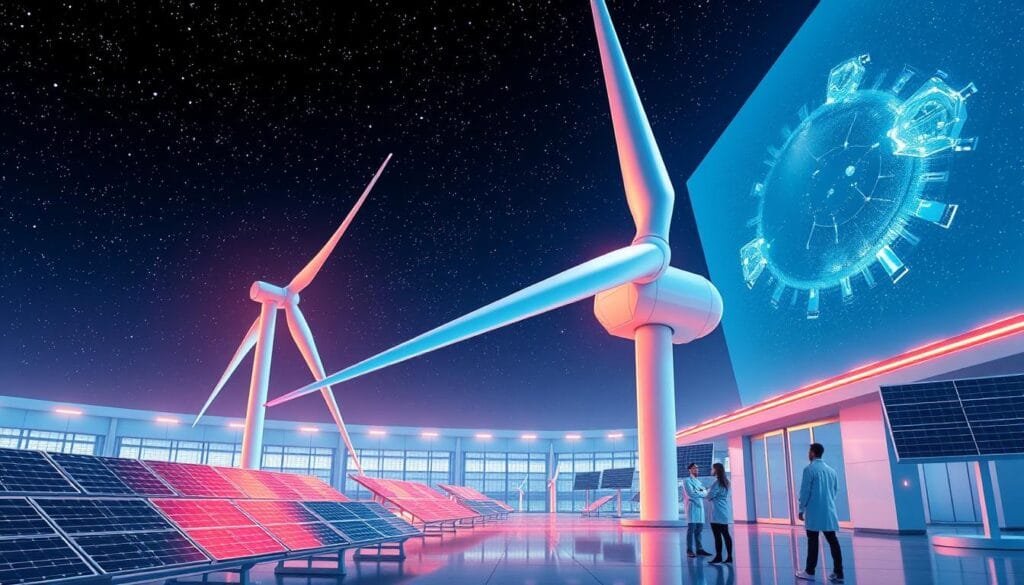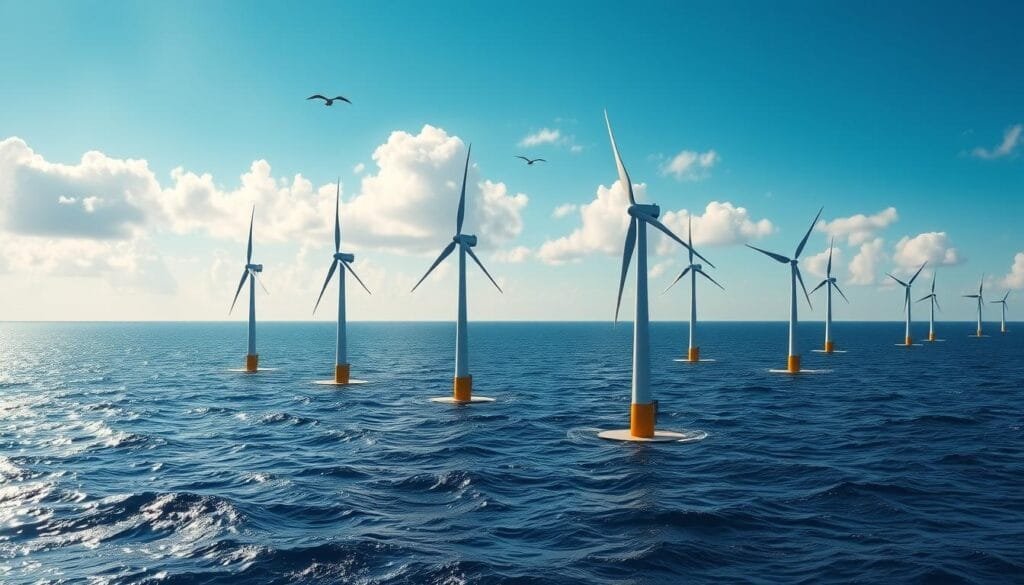Did you know that wind energy powers 10% of the world’s energy? The history of wind turbines goes back over a century. It’s a story of human innovation and the growth of renewable energy.
Wind power is one of humanity’s greatest technological achievements. Finding out who invented the wind turbine shows us a story of genius inventors from around the world. They all played a part in this groundbreaking technology.
Wind turbines have changed a lot over the years. In the 11th century, they were used for grinding grain. Later, they became machines that could make electricity. Between 1887 and 1891, inventors in the U.S., Scotland, and Denmark made the first turbines that could produce electricity. This was a big step forward in renewable energy.
The story of wind turbine technology is not just about new machines. It’s also about changing how we think about energy. Pioneers like Poul la Cour in Denmark and James Blyth in Scotland were key. They experimented with using wind energy and helped train the next generation of engineers.
Key Takeaways
- Wind turbine technology dates back over 100 years
- Multiple international inventors contributed to wind energy development
- Early turbine designs were adapted from grain milling mechanisms
- First electricity-producing turbines emerged between 1887-1891
- Wind energy now produces 10% of global energy
Ancient Origins of Wind Power
Wind energy has a long history, dating back thousands of years. Humans have used wind power for ages, creating technologies that helped start modern renewable energy.
The first windmill inventors saw wind’s power long before today’s tech. Archaeology shows how ancient people used wind for important tasks.
Early Maritime Applications
Sailing boats are a key example of early wind use. They date back to about 5,000 BC. Ancient cultures showed great skill in using wind for sailing.
- Earliest sailing boats found in Mesopotamia
- They used wind direction for navigation
- Wind power helped with maritime trade
First Wind-Powered Mechanisms
Wind pioneers created key machines for society. In 200 BC, Chinese engineers made wind-powered water pumps. This showed early tech skills in using natural resources.
| Region | Wind Power Application | Approximate Time Period |
|---|---|---|
| China | Water Pumping | 200 BC |
| Middle East | Grain Grinding | 500-900 AD |
| Persia | Vertical Axis Windmills | 9th Century AD |
Egyptian and Mesopotamian Contributions
Ancient Egyptians and Mesopotamians were true windmill inventors. Archaeology shows they used wind for irrigation 3,700 years ago. This shows their deep understanding of natural energy.
“Wind is the breath of technological innovation, carrying human ingenuity across centuries.” – Anonymous Wind Energy Historian
These early steps paved the way for today’s wind energy. They prove that sustainable energy has a long history of human creativity and resourcefulness.
The Evolution of Windmills in Ancient Persia
Ancient Persia was a leader in using wind power. In the 9th century CE, they created new windmill designs. These changes helped a lot in farming and industry.
In Sistan, on the Iran-Afghanistan border, wind technology started. The panemone windmills were special. They had vertical axes, perfect for dry lands.
“The Persian windmills represented a remarkable leap in engineering and technological understanding for their time.”
These ancient windmills had unique features:
- Vertical axis construction
- Rectangular sail configurations
- Multipurpose functionality for grinding grain
- Water pumping capabilities
They had 6 to 12 rectangular sails. This showed advanced engineering for then. They were made to use wind energy well for farming.
By using wind, Persian engineers solved big problems in water and food. Their work helped start the global wind energy movement.
European Windmill Development in the Middle Ages
The Middle Ages saw a big change in wind power technology in Europe. Pioneers in wind power found new ways to use natural energy. They created advanced machines that changed farming and industry.
Dutch Innovation in Wind Technology
The Netherlands was key in windmill development. By 1200 AD, Dutch inventors built windmills mainly for grinding grain. Their skills made these machines useful for more things.
- First windmills appeared in the Netherlands around 1,200 AD
- Peak period saw over 9,000 windmills in the country
- Currently, approximately 1,000 windmills remain operational
Medieval Wind Power Applications
Windmills were used for more than just grinding grain in medieval times. They were vital for many industrial tasks, like:
- Water pumping
- Paper production
- Oil seed processing
- Wool manufacturing
- Paint production
Technological Advancements in Design
Windmill technology grew fast in the Middle Ages. The post mill was the main design until the 19th century. New ideas made these machines work better.
| Windmill Type | Primary Function | Origin Period |
|---|---|---|
| Vertical-Axle Mill | Grain Processing | 11th Century |
| Hollow-Post Mill | Wetland Drainage | 14th Century |
| Masonry Tower Mill | Industrial Applications | Late 13th Century |
“The windmill represents humanity’s first significant step towards sustainable energy utilization.” – Historical Energy Researcher
Who Invented the Wind Turbine

The journey of wind turbine invention is a key moment in alternative energy. Wind power has a long history, but the shift to electricity-generating turbines was a big leap. It marked a turning point for those working on new energy solutions.
In 1883, Austrian inventor Josef Friedländer made a major breakthrough. He created a wind generator that changed energy production. His invention was shown at the Vienna International Electrical Exhibition. It had a 22-foot diameter, making it quite impressive.
“The future of energy lies in harnessing the power of natural resources” – Josef Friedländer
Key Milestones in Wind Turbine Development
- 1883: Josef Friedländer creates first electricity-generating wind turbine
- 1887: James Blyth builds first windmill for electricity in UK
- 1888: Charles Brush installs first wind turbine in United States
These innovators changed how we make electricity. Friedländer’s invention was a key moment. It showed the power of wind as a renewable energy source.
| Inventor | Year | Key Achievement |
|---|---|---|
| Josef Friedländer | 1883 | First electricity-generating wind turbine |
| James Blyth | 1887 | First UK electricity-generating windmill |
| Charles Brush | 1888 | First US wind turbine for estate lighting |
Their work set the stage for today’s wind energy technology. It changed how we view sustainable power generation.
The Halladay Windmill: First Commercial Success
Daniel Halladay’s invention in the mid-19th century was a big step forward in wind turbine history. He and other innovators changed how we manage water in farming with their smart windmill designs.
In 1854, Halladay patented a self-governing windmill. This invention changed rural life forever. It marked a key moment in the development of wind power.
Technical Specifications
- Wind wheel diameter: 10 feet
- Well depth: 28 feet
- Water transport distance: Over 100 feet
- Operational duration without intervention: 6 months
Revolutionary Design Features
The Halladay Windmill brought new abilities:
- Automatic wind direction adjustment
- Self-regulating speed mechanisms
- Minimal maintenance requirements
- Consistent water pumping performance
Market Impact
Halladay’s invention changed farming in the American West. It was affordable and practical, making it a hit right away.
| Specification | Details |
|---|---|
| Initial Cost | $50 |
| Additional Pump/Pipe Costs | $25 |
| Company Established | 1854 |
| Manufacturing Location | South Coventry |
“The Halladay Windmill represented a key moment in sustainable technology innovation.” – Wind Power Historical Society
By 1872, steel replaced wood, making the windmill stronger and better. Thousands were sold to farmers and ranchers. This started a new era of wind-powered farming solutions.
James Blyth and Early Electrical Generation
James Blyth was a key figure in the history of wind energy. Born in Scotland, he invented a wind turbine in July 1887. This invention was a major breakthrough in renewable energy.
Blyth’s wind turbine was a marvel of its time. It was 33 feet tall and could power:
- Ten 25-volt light bulbs
- A small lathe
- Emergency power systems
Blyth’s invention was truly groundbreaking. He showed the world how to generate electricity from wind before many others. In 1891, he got a UK patent for his “wind engine”. He also won the Brisbane Gold Medal from the Royal Scottish Society of Arts.
“Wind power represents the future of sustainable energy generation.” – James Blyth, 1891
Blyth’s biggest success was powering the Montrose Lunatic Asylum. His turbine worked for 30 years. This was a major achievement for wind energy.
But Blyth’s work was ahead of its time. No more wind turbines were built in the UK for 64 years. This shows how visionary his invention was.
Charles Brush’s Groundbreaking Wind Turbine Design
Charles F. Brush, an American inventor, changed the game with his wind turbine in 1887. His design marked a big step in renewable energy.
Brush’s turbine was 60 feet tall and had a unique design. It had a fan-shaped wheel with 144 cedar blades. It was mounted on a 60-foot tower.
It could generate about 1,200 watts of electricity. This power was enough to light about 100 incandescent lights.
Technical Innovations
The turbine’s design was ahead of its time. It had a pulley system that was impressive. A single wheel turn could make 50 dynamo revolutions.
Scientific American called it the only successful electric lighting system powered by wind in 1890.
Impact on Modern Engineering
Brush’s work was a big step for wind energy. Even though it was not cost-effective back then, it showed the power of wind energy. His work inspired others to keep working on renewable energy.
“The future of energy lies in understanding and harnessing natural resources intelligently.” – Charles F. Brush
| Specification | Details |
|---|---|
| Tower Height | 60 feet |
| Number of Blades | 144 |
| Power Generation | 1,200 watts |
| Year Constructed | 1887-1888 |
The NASA Wind Program and Modern Development

In the 1970s, NASA became key players in wind power. They started a wind turbine development program in 1975. This was in response to high oil prices and the need for green energy.
NASA’s wind energy program introduced several groundbreaking prototypes. These prototypes greatly improved wind turbine technology:
- MOD-0: First prototype with 100 kW power rating
- MOD-1: World’s first 2 MW turbine
- MOD-2: Advanced multi-unit wind generation system
NASA’s team faced big challenges. They learned a lot about wind turbine design and cost. Back then, most turbines were only 25 kW. NASA dreamed of turbines that were 200-300 feet wide.
| Turbine Model | Power Output | Years of Operation |
|---|---|---|
| MOD-0 | 100 kW | 1975-1982 |
| MOD-1 | 2 MW | 1979-1981 |
| MOD-2 | 7.5 MW (total) | 1982-1988 |
NASA’s wind turbine research program laid the foundation for today’s renewable energy. It showed the power of large-scale wind energy.
“The future of energy lies not in fossil fuels, but in our ability to harness natural, sustainable resources.” – NASA Wind Energy Research Team
Birth of Commercial Wind Farms
The start of commercial wind farms was a big step in wind turbine history. In the late 1970s and early 1980s, innovators looked for new ways to get energy. This led to a big change in how wind power was used.
The first big wind farm was set up in New Hampshire in December 1980. It had 10 wind turbines. This showed that wind energy could be made on a large scale.
Pioneering Wind Farm Developments
Important moments in the growth of commercial wind farms were:
- First U.S. wind farm in New Hampshire (1980)
- First UK wind farm at Delabole (1991)
- California’s fast growth in wind energy
Global Expansion of Wind Energy
Wind farms around the world grew fast during this time. Key reasons for this growth were:
- Government tax breaks
- Lower costs for technology
- More people caring about the environment
| Year | Wind Capacity (Megawatts) | Key Development |
|---|---|---|
| 1980 | 20 | First Commercial Wind Farm |
| 1985 | 1,000 | California Wind Expansion |
| 1990 | 2,200 | Global Leadership in Wind Energy |
“The birth of commercial wind farms was a key moment for renewable energy technology.” – Energy Innovations Research Institute
By the mid-1990s, wind farms were no longer just experiments. They were real places making energy. The innovators had shown that wind power was a good alternative energy source.
Offshore Wind Power Innovation

The world of wind energy has changed a lot with offshore wind power. In 1991, Danish innovators started the first offshore wind farm at Vindeby. This was a big step for those working on green energy solutions.
Floating wind technology is a big leap in renewable energy. It lets us use wind power in deeper waters. This means we can make more energy than before.
- Floating wind projects enable access to deeper waters
- Stronger winds can now be harnessed in previously inaccessible locations
- Expanded global wind energy deployment
Offshore wind technology has grown a lot. ORE Catapult, started in 2013, has helped a lot with research and development.
| Year | Technological Milestone |
|---|---|
| 1991 | First Offshore Wind Farm (Vindeby, Denmark) |
| 2003 | UK’s First Offshore Wind Farm (Blyth) |
| 2013 | ORE Catapult Established |
Wind energy leaders keep finding new ways to improve. Now, wind farms can make almost 35% of the energy they try to. The cost of wind energy has dropped a lot too, from over 55 cents in 1980 to under 3 cents today.
“Offshore wind represents the next frontier of renewable energy innovation” – Renewable Energy Expert
The future of offshore wind power is bright. New technologies are making it possible to produce more sustainable energy.
Technological Breakthroughs in Wind Turbine Design
The history of wind turbines has seen big changes. These changes have made green tech dreams come true. Today, wind energy tech is more efficient and has new designs. These innovations are changing the face of renewable energy.
Material Science Revolution
New materials have made wind turbines better. Green tech leaders have used carbon fiber composites. This has led to:
- Lighter blades
- Stronger turbines
- Better energy capture
Efficiency Performance Metrics
Wind turbine tech has gotten a lot better. New ideas have improved energy capture and how turbines work with the grid.
| Technology Metric | Historical Value | Current Value |
|---|---|---|
| Tower Height | 30 meters | 90 meters |
| Rotor Diameter | 30 meters | 125 meters |
| Power Capacity | 0.2 MW | 3 MW |
Emerging Technological Innovations
Wind turbine history keeps getting more exciting. New tech is making turbines even better. Soon, we’ll see:
- Turbines that are 169 meters tall
- 150-meter rotors
- Smarter ways to smooth out power
Recent NREL studies show we could get 80% more wind energy in the US by 2025 with new tech.
The future of wind energy is bright. With better materials, designs, and ways to capture energy, green tech is moving fast.
Modern Wind Energy Leaders and Pioneers
The world of wind power has changed a lot in recent years. Countries like China, the United States, and Germany are leading the way. They are pushing for new technologies and sustainable energy solutions.
China is leading in wind energy, making up 33.6% of the world’s production. Their big plans for renewable energy make them very important in this field.
“The future of energy lies in innovation and sustainable technologies” – Global Wind Energy Council
Some big changes in wind energy include:
- Big improvements in how turbines work
- More wind farms going into the ocean
- More money coming in from big investors
- Leaders from car companies moving to wind energy
The United States is also making big moves. The Department of Energy says wind energy could cut 12.3 gigatonnes of greenhouse gases by 2050. This is like taking 1.3 million cars off the road and creating over 600,000 green jobs.
European innovators like Henrik Stiesdal have also played a big role. Stiesdal has been granted over 90 European patents and filed around 900 international patent applications. This shows how much innovation is happening in this area.
Conclusion
The history of wind turbines is truly fascinating. It shows how simple windmills evolved into advanced sustainable technology. By 2020, over 650 gigawatts of power were made by hundreds of thousands of turbines. This shows how far technology has come.
People who innovate in sustainable technology have made big changes. From Charles F. Brush’s first 12 kW turbine in 1887 to today’s huge turbines, it’s a huge leap. Now, countries like China and the United States are leading in wind power, showing their commitment to green energy.
Wind power is also good for the environment. A 2009 study found it has the lowest greenhouse gas emissions and best social impacts. With new tech and growing energy needs, wind turbines are key to clean energy.
Looking ahead, wind energy is a beacon of hope for a greener future. Thanks to innovators, researchers, and leaders, wind turbines will keep fighting climate change and meeting energy demands.

